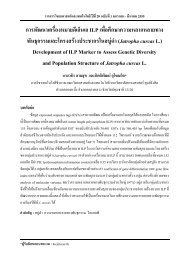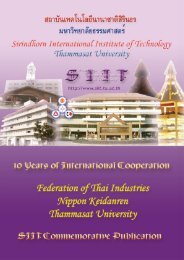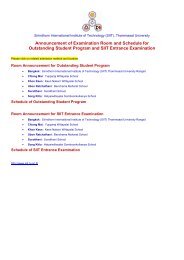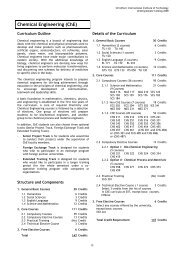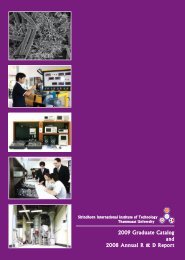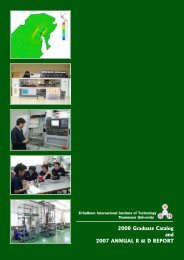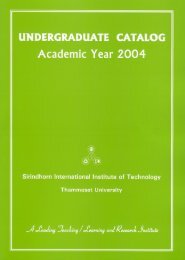2006 Graduate Catalog and 2005 Annual R & D Report - Sirindhorn ...
2006 Graduate Catalog and 2005 Annual R & D Report - Sirindhorn ...
2006 Graduate Catalog and 2005 Annual R & D Report - Sirindhorn ...
Create successful ePaper yourself
Turn your PDF publications into a flip-book with our unique Google optimized e-Paper software.
<strong>2006</strong> <strong>Graduate</strong> <strong>Catalog</strong> <strong>and</strong> <strong>2005</strong> <strong>Annual</strong> R & D <strong>Report</strong><br />
<strong>Sirindhorn</strong> International Institute of Technology (SIIT)<br />
Research Interests:<br />
Digital Image Processing (especially Medical<br />
Image Processing)<br />
Feature detection <strong>and</strong> image segmentation are the<br />
primary areas of my research interests. “Analysis of<br />
3-D maxillofacial image data” is the title of my<br />
doctoral dissertation, which focused on the analysis of<br />
the human dentition <strong>and</strong> jawbone for orthodontic<br />
treatment <strong>and</strong> surgery. The extraction of anatomical<br />
features in retinal images is one of my recent<br />
research topics.<br />
Computer Vision <strong>and</strong> Remote Sensing<br />
Depth estimation <strong>and</strong> motion analysis are the areas of<br />
my long-term research interests. Depth estimation is<br />
the central issue in dealing with stereo (or more)<br />
images, while motion analysis is concerned about the<br />
process of time-sequential images. I am particularly<br />
interested in the “correspondence problem” that has<br />
to be solved for estimating both depth <strong>and</strong> motion.<br />
Object Classification <strong>and</strong> Recognition<br />
Image underst<strong>and</strong>ing is another area of my interests.<br />
This category has various applications for<br />
bioinformatics <strong>and</strong> industry, such as security control,<br />
parts inspection, grading <strong>and</strong> sorting, etc. A popular<br />
research topic in bioinformatics is human face<br />
recognition which I have worked on.<br />
Dr. Waree Kongprawechnon<br />
Associate Professor<br />
B.Eng. (1 st Class Honors) in Electrical Engineering, Chulalongkorn University, Thail<strong>and</strong><br />
M.Eng. in Control Engineering, Osaka University, Japan<br />
Ph.D. in Mathematical Engineering <strong>and</strong> Information Physics, University of Tokyo, Japan<br />
Areas of Specialization: The theory in H ∞ control, the theory in Robust control.<br />
Research Interests:<br />
H ∞ Control<br />
The advent of H ∞ control was a truly remarkable<br />
innovation in multivariable theory. It eliminated the<br />
classical/modern dichotomy by formulating the design<br />
issues of classical control property <strong>and</strong> has solved it<br />
based on the state-space tool of modern theory. The<br />
theory-practice gap was no longer a significant issue<br />
at the beginning of the 1990s due to a number of<br />
successful applications of H ∞ control to real design<br />
problems, especially applications of H ∞ control based<br />
robust control theory.<br />
Robust Control<br />
No mathematical system can exactly model a<br />
physical system. Nowadays it is gradually being<br />
recognized that the real issue of control engineering<br />
we were faced with was the difficulty of modeling the<br />
plant to be controlled. For this reason we must be<br />
aware of how modeling errors might adversely affect<br />
the performance of a control system. Robust control<br />
theory became the most popular area that was<br />
expected to deal with model uncertainty.<br />
School of Information <strong>and</strong> Computer Technology<br />
Faculty Members <strong>and</strong> Research Interests, <strong>2006</strong><br />
Dr. Bunyarit Uyyanonvara<br />
Assistant Professor<br />
B.Sc. (1 st Class Honors) in Science (Physics), Prince of Songkhla University, Thail<strong>and</strong><br />
Ph.D. in Image Processing, King's College, London, UK<br />
Areas of Specialization: Image processing, Texture segmentation, Relaxation labeling, Medical imaging<br />
Research Interests:<br />
Image Segmentation Using Texture <strong>and</strong><br />
Relaxation Labeling Algorithms<br />
When normal density or intensity segmentation is not<br />
effective enough, a new representation of texture<br />
which is derived from the spatial energy of the texture<br />
is introduced in order to segment the given image.<br />
From the energy values, a 2D histogram of texture is<br />
generated. The texture histogram is used to<br />
discriminate textures <strong>and</strong> to retrieve image<br />
segmentation. In an attempt to assess the similarities<br />
in the regional areas, the property of adjacency could<br />
be useful. This characteristic of pixels is defined as a<br />
co-occurrence matrix, which is an important tool in<br />
Image Segmentation using Texture <strong>and</strong> Relaxation<br />
Labeling Algorithms.<br />
22




